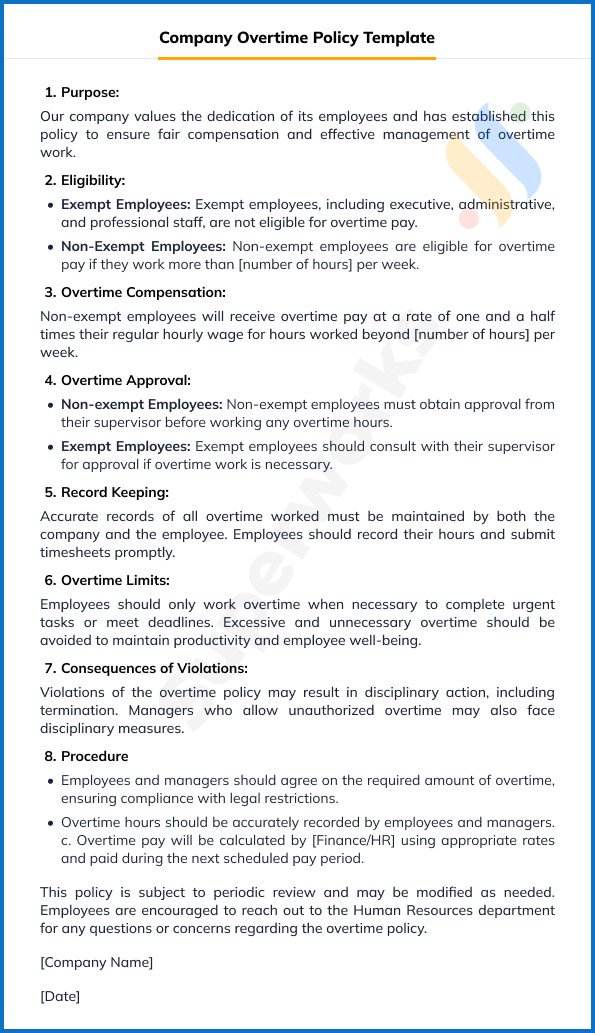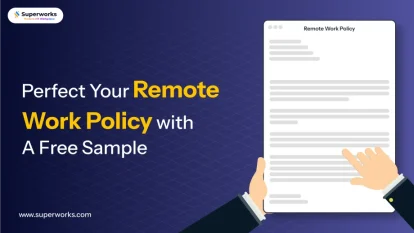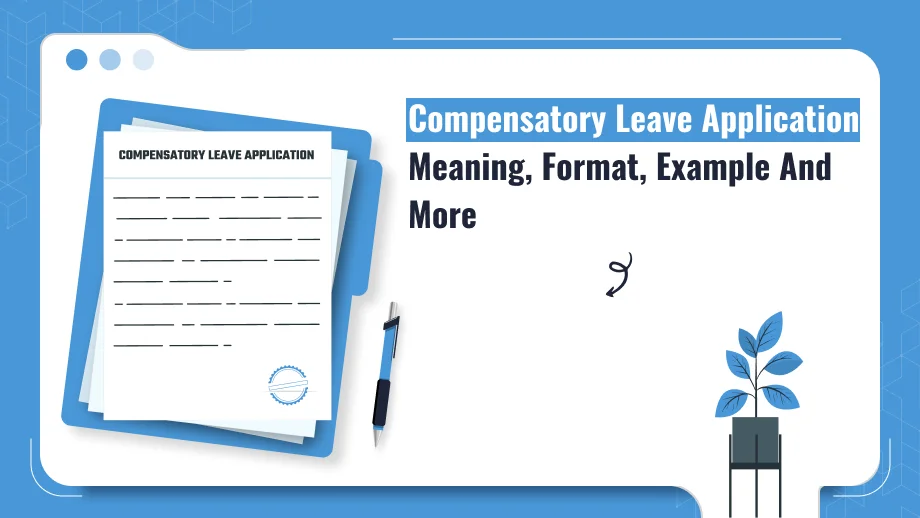Grab a chance to avail 6 Months of Performance Module for FREE
Book a free demo session & learn more about it!
-
Will customized solution for your needs
-
Empowering users with user-friendly features
-
Driving success across diverse industries, everywhere.
Grab a chance to avail 6 Months of Performance Module for FREE
Book a free demo session & learn more about it!
Superworks
Modern HR Workplace
Your Partner in the entire Employee Life Cycle
From recruitment to retirement manage every stage of employee lifecycle with ease.


Seamless onboarding & offboarding
Automated compliance & payroll
Track performance & engagement
Your Quick Guide to Overtime Policy – Get a FREE TEMPLATE!
- overtime policy template
- 7 min read
- July 20, 2023

Unlocking the full potential of your workforce while maintaining a healthy work-life balance is a delicate balancing act for any organization. Have you ever wondered how to develop an overtime policy that not only ensures productivity but also promotes employee well-being? Well, you’re not alone.
With the demands of today’s dynamic business environment, it’s crucial to establish clear guidelines and boundaries.
In this blog, we’ll explore everything about overtime policy. We’ll also provide you with a FREE company
overtime policy template.
Let’s dive in!
Note:You can download directly from here and edit as per your need.
- What is Overtime Policy?
- Meaning of Overtime Hours & Overtime Pay
- Types of Overtime
- Benefits of Tracking Work Overtime Hours
- Steps to Draft an Overtime Policy
- 1. Understand legal requirements:
- 2. Define eligibility criteria:
- 3. Establish overtime calculation:
- 4. Set limits on overtime:
- 5. Address mandatory overtime:
- 6. Outline voluntary overtime:
- 7. Address record-keeping:
- 8. Communicate overtime approval process:
- 9. Address compensatory time off:
- 10. Communicate the policy:
- 11. Review & update:
- Company Overtime Policy Template
- Bottom Line
What is Overtime Policy?
An overtime policy is a set of guidelines and rules established by an organization to regulate and govern the conditions and compensation for employees who work beyond their regular working hours. It outlines the procedures and requirements for employees to qualify for overtime pay. The overtime policy in IT companies, the healthcare industry, and others is different.
Work overtime policies typically specify the maximum number of hours an employee can work in a day or week before they are eligible for overtime, the rate of pay for overtime work, and any additional benefits or incentives that may apply.
Companies nowadays use attendance management & tracking systems to track working overtime effortlessly.
Meaning of Overtime Hours & Overtime Pay
Overtime hours refers to the additional hours worked by an employee beyond their regular working hours as defined by their employment contract or company policies.
Overtime pay is a form of additional overtime compensation provided to employees (other than their minimum wages) for the expected overtime period. Needless to mention, overtime pay laws differ from company to company.
The purpose of this pay is to acknowledge and reward employees for their extra effort, time, and dedication. It serves as an incentive for employees to take on additional work when necessary and ensures that they are fairly compensated for their contributions beyond the standard working hours.
Types of Overtime
When it comes to overtime, there are several types that organizations commonly utilize:
-
Mandatory overtime:
Mandatory overtime is very common. It is simply when employees are required to cover extra mandatory working hours due to business needs or unforeseen circumstances.
-
Excessive overtime:
When you work prolonged periods beyond your regular hours, it is termed excessive overtime. Need to mention, frequent and excessive overtime often lead to fatigue, and burnout if not managed effectively.
-
Voluntary overtime:
Employees choose to work additional hours based on their preferences or to earn extra income.
-
Time off in Lieu (TOIL):
In the time off in lieu, employees are granted time off in exchange for the extra hours they worked, providing flexibility in balancing work and personal lives.
-
Overtime Abuse
It refers to the practice of working unauthorized excessive hours to receive higher compensation at a later time.
Benefits of Tracking Work Overtime Hours
Tracking work overtime hours can bring several benefits to both employees and organizations. Here are the key advantages of the bullet-point format:
For Employees:
-
Fair compensation:
Accurate tracking of overtime hours helps companies to compensate employees fairly for their extra work and time.
-
Work-life balance:
Overtime tracking helps employees and their supervisors monitor and manage their workload, allowing for better work-life balance and preventing excessive or prolonged overtime.
-
Legal compliance:
Keeping a record of overtime hours ensures that organizations comply with labor laws and regulations regarding overtime pay and working hour limits.
-
Recognition and rewards:
Transparent tracking of overtime hours can provide a basis for acknowledging and rewarding employees who consistently go above and beyond their regular duties, boosting morale and motivation.
Read More – Unveiling the Secrets to a Successful Leave Policy for Employees

Want to design an effective overtime policy? We’ll help you!
You need our HR Toolkit with 200+ templates of HR letters, emails, and business policies. With an HR toolkit, you will never have to spend hours or days designing policies for overtime management. It can be done in a second!
So, if you are ready to try Superworks’ HR toolkit and revamp HR processes, then,
For Organizations:
-
Cost control:
Tracking overtime hours helps organizations monitor and control labor costs associated with extra work, allowing them to make informed decisions regarding hiring, staffing levels, and workload distribution.
-
Resource allocation:
Accurate overtime tracking enables organizations to identify busy periods or tasks that consistently require extra hours, facilitating better resource allocation and planning.
-
Productivity optimization:
By analyzing overtime data, organizations can identify areas where efficiency improvements can be made, such as streamlining processes, redistributing tasks, or implementing automation. To record overtime hours accurately, you can use Superworks.
-
Risk management:
Tracking overtime hours aids in identifying patterns of excessive or prolonged overtime, which can lead to burnout, decreased productivity, and increased employee turnover. Taking proactive measures to address these patterns mitigates risks to employee well-being and organizational success.
Overall, tracking work overtime hours provides transparency, ensures fair compensation, promotes work-life balance, and enables organizations to make informed decisions, leading to improved productivity, employee satisfaction, and legal compliance.
Steps to Draft an Overtime Policy
Drafting an effective overtime policy involves careful consideration of various factors. Here are the steps to guide you through the process:
1. Understand legal requirements:
Familiarize yourself with labor laws and regulations related to overtime in your jurisdiction to ensure compliance.
2. Define eligibility criteria:
Determine which employees are eligible for overtime, such as non-exempt employees or those who meet specific job classifications or salary thresholds.
3. Establish overtime calculation:
Specify how overtime will be calculated, such as using a time-and-a-half or double-time rate for hours worked beyond the standard workweek or workday. HRMS software such as Superworks comes with an overtime management system that helps manage overtime requests, oversee overtime calculation in india is mandatory, track scheduled working hours, get real-time data on unauthorized overtime employees, and much more. Such an overtime system not just empowers managers accurately record overtime or excessive working hours but also helps them acquire data on employees subject to disciplinary action.
4. Set limits on overtime:
Set employee overtime rules by determining the maximum number of hours employees can work in a day, week, or pay period before qualifying for overtime, taking legal requirements and employee well-being into account.
5. Address mandatory overtime:
Decide whether mandatory overtime will be required in certain situations and communicate the circumstances under which it may apply.
6. Outline voluntary overtime:
Define the process for employees to voluntarily work extra hours and any additional overtime compensation or benefits that may be associated with it.
7. Address record-keeping:
Specify how overtime hours will be recorded, whether through a time-tracking system, manual Timesheet, or other methods, ensuring accuracy and transparency. You can also use HRMS software to record overtime timely.
8. Communicate overtime approval process:
Outline the procedure for employees to request and obtain approval for overtime work, including any specific documentation or supervisor authorization required.
9. Address compensatory time off:
Determine if employees have the option to take time off instead of overtime pay and establish guidelines for accumulating and utilizing compensatory time.
10. Communicate the policy:
Communicate the overtime policy to all employees, ensuring they understand the eligibility criteria, calculation methods, approval process, and any other relevant details.
11. Review & update:
Regularly review and update the overtime reports to align with changing legal requirements, industry standards, and organizational needs.
Now that you know how to write it, here’s a bonus for you – a FREE overtime policy template!
Company Overtime Policy Template
Hope this overtime policy sample saves you time and effort:
Bottom Line
In conclusion, understanding and implementing an effective overtime policy is crucial for any organization. This guide has provided valuable insights, transitioning from the meaning of overtime to providing a free template to streamline the process. By utilizing this quick guide, employers can ensure fairness, compliance, and employee satisfaction when it comes to managing overtime hours. Don’t overlook the importance of a well-defined overtime policy – it’s an investment in productivity and employee well-being.
Also, do not forget to check our HR toolkit! | official leave application format | online payroll software demo





